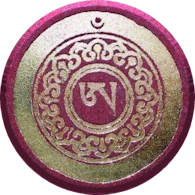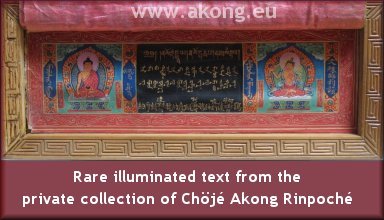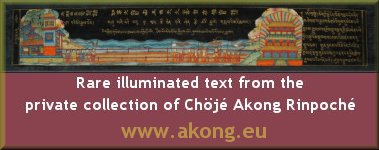
Akong Rinpoché Establishing Buddha-Dharma
Part Ten: Getting the Right Teachers
Of note, in this pioneering work to bring Tibetan buddhadharma to a new world, was Rinpoché’s insistence that each new text taught be taught by the very best person possible. He believed very much in tendrel, the notion of inter-dependence, whereby the first link in a process is a very important one, colouring all that will follow. He truly saw it as his duty to get pure, wise masters with powerful lineage transmissions of a text to be the ones who taught it and who gave its scriptural transmission—lung.
 The counterpart to the above and something understandably little known to most people concerns the number of Tibetan teachers who were politely but firmly made to understand that their teachings or presence were not required at Samye Ling. Often, as more and more Tibetans started visiting the West, their European aides would contact Samye Ling to offer a visit from master such-and-such.
Akong Rinpoché knew that being able to say they had taught in Samye Ling would be a “feather in the cap” for some of the rinpochés and a good item to have on their CV. He was also painfully aware that many of these “rinpochés” or “tulkus” were not nearly as pure, as learned or as realised in meditation as their own publicised CVs inplied or said. He had inside knowledge.
The counterpart to the above and something understandably little known to most people concerns the number of Tibetan teachers who were politely but firmly made to understand that their teachings or presence were not required at Samye Ling. Often, as more and more Tibetans started visiting the West, their European aides would contact Samye Ling to offer a visit from master such-and-such.
Akong Rinpoché knew that being able to say they had taught in Samye Ling would be a “feather in the cap” for some of the rinpochés and a good item to have on their CV. He was also painfully aware that many of these “rinpochés” or “tulkus” were not nearly as pure, as learned or as realised in meditation as their own publicised CVs inplied or said. He had inside knowledge.
In particular, he confided to the author the names of some teachers about whom the XVIth Karmapa had warned him, saying that they would become very popular but that their activities would damage dharma and damage people, rather than help them. Although the image many people had of the XVIth Karmapa was one of constant radiance and smiles and great composure, he was also someone deeply moved and upset by the desecration of dharma, especially by those who should have known better. He was known to have cried once at seeing sacred antiques being used as ashtrays in ambassadorial dwellings. The Karmapa was very concerned about these teachers, although at that early time there seemed not too much cause for alarm in their relatively-low-key activities. However, true to the Karmapa’s vision transcending time, one of them became infamous through sex scandals yet is still a very popular teacher; another has made public and taught—outside of retreat—sacred practices from the Six Yogas of Naropa that were under a seal of secrecy; a third has done something similar and gained fame through his retreats on a version of one of the Six Yogas that he has modified to give students spectacular results, whether they have devotion and renunciation or not.
 The author witnessed how these warnings of the Karmapa were a hard burden to bear for Akong Rinpoché. When he refused to have anything to do with these teachers but could not say why—without breaking his bodhisattva vow of never saying ill of another bodhisattva or without making splits and dark waves in the Western dharma communities—he himself became accused of jealousy, prejudice
and narrow-mindedness. The outcome of this was, however, very positive for Samye Ling. Under his direction, directly or indirectly until his passing, only reputable teachers were allowed to teach there. People coming to Samye Ling knew they were in safe and approved hands. As best as he could, Akong Rinpoché also tried to get teachers to teach their own areas of expertise and would request them teach only those things. This highlighted another problem he often mentioned, namely that once someone carries
the title rinpoché or tulku, many people in the wider public think that person can teach anything and everything. In private, disciples will also ask for advice in all sorts of areas, with a kind of belief that the rinpoché in question must be able to answer, simply because he is a rinpoché.
The author witnessed how these warnings of the Karmapa were a hard burden to bear for Akong Rinpoché. When he refused to have anything to do with these teachers but could not say why—without breaking his bodhisattva vow of never saying ill of another bodhisattva or without making splits and dark waves in the Western dharma communities—he himself became accused of jealousy, prejudice
and narrow-mindedness. The outcome of this was, however, very positive for Samye Ling. Under his direction, directly or indirectly until his passing, only reputable teachers were allowed to teach there. People coming to Samye Ling knew they were in safe and approved hands. As best as he could, Akong Rinpoché also tried to get teachers to teach their own areas of expertise and would request them teach only those things. This highlighted another problem he often mentioned, namely that once someone carries
the title rinpoché or tulku, many people in the wider public think that person can teach anything and everything. In private, disciples will also ask for advice in all sorts of areas, with a kind of belief that the rinpoché in question must be able to answer, simply because he is a rinpoché.
Akong Rinpoché knew some rinpochés as being good scholars: even then, their scholarly prowess would have its weak areas and strong areas. He knew that some rinpochés were good meditators with true meditation experience under their belt: even then, that did not make them masters of all meditation practices. Thus he did his best to get each visiting teacher to teach what he (Akong Rinpoché) knew them to be best at. This did not always go down well with the public and sometimes not with the teacher either.
.....this narrative continues .... "A Teaching Programme"
